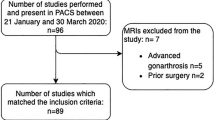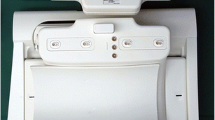Abstract
Despite being one of the most common indications for surgery, data on the types of meniscus tear that should be treated surgically are limited. Improving patient selection requires agreement on meniscus tear description. This study evaluates a simple MRI tear classification system for inter-observer agreement. Knee MRI examinations from 57 subjects from the Osteoarthritis Initiative cohort were reviewed by two sub-specialty trained, musculoskeletal radiologists. Based on two pulse sequences, each meniscus was classified by: tear or no tear; location of tear in anterior, middle or posterior third or multiple thirds; and displaced or non-displaced radial, horizontal, longitudinal or complex tear pattern. A tear was defined as signal abnormality extending to the surface on at least two images and displacement as more than 2 mm of extrusion or separation measured orthogonal to the tear plane. Kappa, weighted Kappa and percentage agreement were calculated. For the medial meniscus, Kappa and percentage agreement estimates were, respectively: the presence of tear, 0.79 and 89.5%; tear with displacement, 0.70 (weighted Kappa) and 66.0%; tear description, 0.47 and 61.4%; tear location, 0.64 and 79.0%. For the lateral meniscus, estimates were: the presence of tear, 0.75 and 89.5%; tear with displacement, 0.81 (weighted Kappa) and 86.0%; tear description, 0.56 and 78.9%; tear location, 0.74 and 87.7%. The strength of agreement between readers was moderate to substantial underscoring the challenge of meniscus tear classification.

Similar content being viewed by others
References
Burr DB, Radin EL (1982) Meniscal function and the importance of meniscal regeneration in preventing late medical compartment osteoarthrosis. Clin Orthop Relat Res 171:121–126
De Smet AA, Tuite MJ (2006) Use of the “two-slice-touch” rule for the MRI diagnosis of meniscal tears. AJR Am J Roentgenol 187(4):911–914. https://doi.org/10.2214/ajr.05.1354
De Smet AA (2012) How I diagnose meniscal tears on knee MRI. AJR Am J Roentgenol 199(3):481–499. https://doi.org/10.2214/ajr.12.8663
Nguyen JC, De Smet AA, Graf BK, Rosas HG (2014) MR imaging-based diagnosis and classification of meniscal tears. Radiographics 34(4):981–999. https://doi.org/10.1148/rg.344125202
Antony B, Driban JB, Price LL, Lo GH, Ward RJ, Nevitt M, Lynch J, Eaton CB, Ding C, McAlindon TE (2017) The relationship between meniscal pathology and osteoarthritis depends on the type of meniscal damage visible on magnetic resonance images: data from the Osteoarthritis Initiative. Osteoarthr Cartil 25(1):76–84. https://doi.org/10.1016/j.joca.2016.08.004
Englund M, Roemer FW, Hayashi D, Crema MD, Guermazi A (2012) Meniscus pathology, osteoarthritis and the treatment controversy. Nat Rev Rheumatol 8(7):412–419. https://doi.org/10.1038/nrrheum.2012.69
Jarraya M, Roemer FW, Englund M, Crema MD, Gale HI, Hayashi D, Katz JN, Guermazi A (2017) Meniscus morphology: does tear type matter? A narrative review with focus on relevance for osteoarthritis research. Semin Arthr Rheum 46(5):552–561. https://doi.org/10.1016/j.semarthrit.2016.11.005
Englund M, Guermazi A, Gale D, Hunter DJ, Aliabadi P, Clancy M, Felson DT (2008) Incidental meniscal findings on knee MRI in middle-aged and elderly persons. N Engl J Med 359(11):1108–1115. https://doi.org/10.1056/NEJMoa0800777
Aagaard H, Verdonk R (1999) Function of the normal meniscus and consequences of meniscal resection. Scand J Med Sci Sports 9(3):134–140
Monk P, Garfjeld Roberts P, Palmer AJ, Bayliss L, Mafi R, Beard D, Hopewell S, Price A (2017) The urgent need for evidence in arthroscopic meniscal surgery. Am J Sports Med 45(4):965–973. https://doi.org/10.1177/0363546516650180
Abram SGF, Beard DJ, Price AJ (2018) National consensus on the definition, investigation, and classification of meniscal lesions of the knee. Knee 25(5):834–840. https://doi.org/10.1016/j.knee.2018.06.001
Hunter DJ, Guermazi A, Lo GH, Grainger AJ, Conaghan PG, Boudreau RM, Roemer FW (2011) Evolution of semi-quantitative whole joint assessment of knee OA: mOAKS (MRI Osteoarthritis Knee Score). Osteoarthr Cartil 19(8):990–1002. https://doi.org/10.1016/j.joca.2011.05.004
Kornaat PR, Ceulemans RY, Kroon HM, Riyazi N, Kloppenburg M, Carter WO, Woodworth TG, Bloem JL (2005) MRI assessment of knee osteoarthritis: knee osteoarthritis scoring system (KOSS)–inter-observer and intra-observer reproducibility of a compartment-based scoring system. Skeletal Radiol 34(2):95–102. https://doi.org/10.1007/s00256-004-0828-0
Peterfy CG, Guermazi A, Zaim S, Tirman PF, Miaux Y, White D, Kothari M, Lu Y, Fye K, Zhao S, Genant HK (2004) Whole-organ magnetic resonance imaging score (WORMS) of the knee in osteoarthritis. Osteoarthr Cartil 12(3):177–190. https://doi.org/10.1016/j.joca.2003.11.003
Peterfy CG, Schneider E, Nevitt M (2008) The osteoarthritis initiative: report on the design rationale for the magnetic resonance imaging protocol for the knee. Osteoarthr Cartil 16(12):1433–1441. https://doi.org/10.1016/j.joca.2008.06.016
Hoorntje A, Witjes S, Koenraadt KLM, Aarts R, Weert T, van Geenen RCI (2019) More severe preoperative Kellgren–Lawrence grades of knee osteoarthritis were partially associated with better postoperative patient-reported outcomes in TKA patients. J Knee Surg 32(3):211–217. https://doi.org/10.1055/s-0038-1635114
Kellgren JH, Lawrence JS (1957) Radiological assessment of osteo-arthrosis. Ann Rheum Dis 16(4):494–502
Duncan ST, Khazzam MS, Burnham JM, Spindler KP, Dunn WR, Wright RW (2015) Sensitivity of standing radiographs to detect knee arthritis: a systematic review of Level I studies. Arthroscopy J Arthrosc Relat Surg 31(2):321–328. https://doi.org/10.1016/j.arthro.2014.08.023
Conaghan PG, Hunter DJ, Maillefert JF, Reichmann WM, Losina E (2011) Summary and recommendations of the OARSI FDA osteoarthritis assessment of structural change working group. Osteoarthr Cartil 19(5):606–610. https://doi.org/10.1016/j.joca.2011.02.018
Landis JR, Koch GG (1977) The measurement of observer agreement for categorical data. Biometrics 33(1):159–174
Sim J, Wright CC (2005) The kappa statistic in reliability studies: use, interpretation, and sample size requirements. Phys Ther 85(3):257–268
Roemer FW, Hunter DJ, Crema MD, Kwoh CK, Ochoa-Albiztegui E, Guermazi A (2016) An illustrative overview of semi-quantitative MRI scoring of knee osteoarthritis: lessons learned from longitudinal observational studies. Osteoarthr Cartil 24(2):274–289. https://doi.org/10.1016/j.joca.2015.08.011
Guermazi A, Roemer FW, Haugen IK, Crema MD, Hayashi D (2013) MRI-based semiquantitative scoring of joint pathology in osteoarthritis. Nat Rev Rheumatol 9(4):236–251. https://doi.org/10.1038/nrrheum.2012.223
Berthiaume MJ, Raynauld JP, Martel-Pelletier J, Labonte F, Beaudoin G, Bloch DA, Choquette D, Haraoui B, Altman RD, Hochberg M, Meyer JM, Cline GA, Pelletier JP (2005) Meniscal tear and extrusion are strongly associated with progression of symptomatic knee osteoarthritis as assessed by quantitative magnetic resonance imaging. Ann Rheum Dis 64(4):556–563. https://doi.org/10.1136/ard.2004.023796
Chahla J, Cinque ME, Godin JA, Sanchez G, Lebus GF, Whalen JM, Price MD, Kennedy NI, Moatshe G, LaPrade RF, Provencher MT (2018) Meniscectomy and resultant articular cartilage lesions of the knee among prospective national football league players: an imaging and performance analysis. Am J Sports Med 46(1):200–207. https://doi.org/10.1177/0363546517737991
Wadhwa V, Omar H, Coyner K, Khazzam M, Robertson W, Chhabra A (2016) ISAKOS classification of meniscal tears-illustration on 2D and 3D isotropic spin echo MR imaging. Eur J Radiol 85(1):15–24. https://doi.org/10.1016/j.ejrad.2015.10.022
Lynch JA, Roemer FW, Nevitt MC, Felson DT, Niu J, Eaton CB, Guermazi A (2010) Comparison of BLOKS and WORMS scoring systems part I. Cross sectional comparison of methods to assess cartilage morphology, meniscal damage and bone marrow lesions on knee MRI: data from the osteoarthritis initiative. Osteoarthr Cartil 18(11):1393–1401. https://doi.org/10.1016/j.joca.2010.08.017
Krampla W, Roesel M, Svoboda K, Nachbagauer A, Gschwantler M, Hruby W (2009) MRI of the knee: how do field strength and radiologist’s experience influence diagnostic accuracy and interobserver correlation in assessing chondral and meniscal lesions and the integrity of the anterior cruciate ligament? Eur Radiol 19(6):1519–1528. https://doi.org/10.1007/s00330-009-1298-5
Bergin D, Hochberg H, Zoga AC, Qazi N, Parker L, Morrison WB (2008) Indirect soft-tissue and osseous signs on knee MRI of surgically proven meniscal tears. AJR Am J Roentgenol 191(1):86–92. https://doi.org/10.2214/ajr.07.3313
Roemer FW, Kwoh CK, Hannon MJ, Hunter DJ, Eckstein F, Wang Z, Boudreau RM, John MR, Nevitt MC, Guermazi A (2015) Can structural joint damage measured with MR imaging be used to predict knee replacement in the following year? Radiology 274(3):810–820. https://doi.org/10.1148/radiol.14140991
Acknowledgements
The OAI is a public/private partnership comprised of five contracts (N01-AR-2-2258; N01-AR-2-2259; N01-AR-2-2260; N01-AR-2-2261; and N01-AR-2-2262) funded by the National Institutes of Health, a branch of the Department of Health and Human Services, and conducted by the OAI Study Investigators. Private funding partners include Merck Research Laboratories, Novartis Pharmaceuticals Corporation, GlaxoSmithKline, and Pfizer Inc. Private sector funding for the OAI is managed by the Foundation for the National Institutes of Health. This manuscript was prepared using an OAI public use data set and does not necessarily reflect the opinions or views of the OAI investigators, the NIH, or the private funding partners.
Funding
No financial support or sponsorship was provided for this work.
Author information
Authors and Affiliations
Contributions
All co-authors take full responsibility for all aspects of the study and the final manuscript. Each author has contributed the following to this submission; made a substantial contribution to the conception and design of the work (KBH; CWH, DLR); made a substantial contribution to the acquisition, analysis or interpretation of data for the work (KBH, JAV, CWH, DLR); drafted the work and revised it critically for important intellectual content (KBH, JAV, CWH, DLR); provided final approval of the version to be published (KBH, JAV, CWH, DLR); and agreed to be accountable for all aspects of the work including ensuring that questions related to the accuracy or integrity of any part of the work are appropriately investigated and resolved (KBH, JAV, CWH, DLR).
Corresponding author
Ethics declarations
Conflict of interest
The authors have no financial relationships to disclose. We have full control of all primary data and agree to allow the journal to review our data if requested.
Additional information
Publisher's Note
Springer Nature remains neutral with regard to jurisdictional claims in published maps and institutional affiliations.
Rights and permissions
About this article
Cite this article
Hoover, K.B., Vossen, J.A., Hayes, C.W. et al. Reliability of meniscus tear description: a study using MRI from the Osteoarthritis Initiative. Rheumatol Int 40, 635–641 (2020). https://doi.org/10.1007/s00296-019-04489-0
Received:
Accepted:
Published:
Issue Date:
DOI: https://doi.org/10.1007/s00296-019-04489-0




